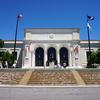More about McSorley's Bar

Contributor
McSorley's used to be Sloan’s go-to spot for libations.
Upon discovering it in 1912, he loved it so much he went back at least five times to paint the location. He painted the back room in 1912, the bar (which this painting depicts) a year later, the bar again with its gallery of memorabilia in 1928 (twice), and one final time in 1930, right in the heart of Prohibition. Slainte!
As a self-admitted socialist and member of the branch of the political party in America, Sloan had a soft spot for the working man and the less fortunate, which manifested in his chosen scenes: streets and boroughs where the middle and lower class would congregate and go about their days. Occasionally he would paint scenes of bars and halls where they would escape the monotony of their routines, like the one depicted here.
The barman in white behind the patrons is Bill McSorley, the son of the original owner, who founded the bar on East Seventh Street in 1854. McSorley’s Old Ale House, as it is properly called, holds the distinction of being the oldest saloon in New York. It serves only two brews, one light and one dark, both in-house. Abraham Lincoln, Teddy Roosevelt, Hunter S. Thompson, and Dustin Hoffman have all entered its doors and took a drink there one time or another. Until 1970, the bar catered exclusively to men. It was opened to women after two lawyers from the National Organization for Women, Faith Seidenberg and Karen De Crow, were refused service after entering the bar. The pair took it to court, landing on the front page of the New York Times on June 26th, ultimately winning because not allowing women into the establishment would be a violation of the Equal Protection Clause of the Constitution.
The painting was in Sloan’s custody until 1924, when it was sold off to the Detroit Museum of Art, where it hangs to this day.
Sources
- Blackwell, Daria. 2015. “'Best Irish Pub in the World' Competition Entry: McSorley's Old Ale House, New York.” The Irish Times. The Irish Times. February 22, 2015. https://www.irishtimes.com/life-and-style/generation-emigration/best-ir…
- Gray, Christopher. 1995. “Streetscapes: The Bridge Cafe;On the Trail of New York's Oldest Surviving Bar.” The New York Times. The New York Times. November 19, 1995. https://www.nytimes.com/1995/11/19/realestate/streetscapes-the-bridge-c…
- jonathan5485. 2011. “McSorley's Bar by John Sloan.” My Daily Art Display. my daily art display. August 12, 2011. https://mydailyartdisplay.wordpress.com/2011/08/12/mcsorleys-bar-by-joh….
- Lichtenstein, Grace. 1970. “McSorley's Admits. Women Under a New City Law.” The New York Times. The New York Times. August 11, 1970. https://www.nytimes.com/1970/08/11/archives/mcsorleys-admits-women-unde….
- Nevius, Michelle, and James Nevius. 2012. “John Sloan's ‘McSorley's Bar.’” Inside the Apple. January 25, 2012. http://blog.insidetheapple.net/2012/01/john-sloans-mcsorleys-bar.html.











